
Home - Search - Browse - Alphabetic Index: 0- 1- 2- 3- 4- 5- 6- 7- 8- 9
A- B- C- D- E- F- G- H- I- J- K- L- M- N- O- P- Q- R- S- T- U- V- W- X- Y- Z
Skylab 4
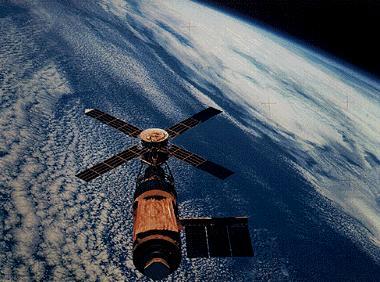
Skylab
Credit: NASA
AKA: Skylab. Launched: 1973-11-16. Returned: 1974-02-08. Number crew: 3 . Duration: 84.05 days. Location: National Air and Space Museum (Smithsonian Institution), Washington, DC.
Final Skylab mission; included observation and photography of Comet Kohoutek among numerous experiments. Completed 1,214 Earth orbits and four EVAs totaling 22 hours, 13 minutes. Increased manned space flight time record by 50%. Rebellion by crew against NASA Ground Control overtasking led to none of the crew ever flying again. Biological experiments included two Mummichog fish (Fundulus heteroclitus).
The space vehicle consisted of a modified Apollo CSM and a Saturn IB launch vehicle. All launch phase events were normal, and the CSM was inserted into a 150.1- by 227.08-km orbit. The rendezvous sequence was performed according to the anticipated timeline. Stationkeeping was initiated about seven and one-half hours after liftoff, and hard docking was achieved about 30 minutes later following two unsuccessful docking attempts. Planned duration of the mission was 56 days, with the option of extending it to a maximum of 84 days.
SKYLAB STATISTICAL SUMMARY
ORBITAL
PARAMETERS 268.1 x 269.5 Miles
ORBITAL
INCLINATION 50 Degrees
ORBITAL
PERIOD APP. 93 MINUTES
DISTANCE/
ORBIT 26,575 MILES
DISTANCE
TRAVELED/Miles SL-2 SL-3 SL-4 TOTALS
(MANNED) 11.5 Million 24.5 Million 34.5 Million 70.5 Million Miles
MISSION
DURATION 28 DAYS 59 DAYS 84 DAYS 171 DAYS
49 MIN 11 HRS 9 MIN 01 HR 16 MIN 13 HRS 14 MIN
NUMBER
OF
REVOLUTIONS
(MANNED) 404 858 1214 2476
______________________________________________________________________
Skylab-4 MANHOUR UTILIZATION
MEDICAL ACTIVITIES 366.7 " 6.1 "
SOLAR OBSERVATIONS 519.0 " 8.5 "
EARTH RESOURCES 274.5 " 4.5 "
OTHER EXPERIMENTS 403.0 " 6.7 "
SLEEP, REST & OFF
DUTY 1846.5 " 30.5 "
PRE/POST SLEEP &
EATING 1384.0 " 23.0 "
HOUSEKEEPING 298.9 " 4.9 "
PHYSICAL TRAINING
& PERSONAL HYGIENE 384.5 " 6.4 "
OTHER (EVA) ETC 571.4 " 9.4 "
TOTAL: 6048.5 " 100 "
Skylab TOTALS FOR SL-2, SL-3 AND SL-4
MEDICAL ACTIVITIES 824.5 " 6.9 "
SOLAR RESOURCES 941.3 " 7.9 "
EARTH RESOURCES 569.4 " 4.8 "
OTHER EXPERIMENTS 712.0 " 6.0 "
SLEEP, REST & OFF
DUTY 3746.6 " 31.5 "
PRE/POST SLEEP &
EATING 2836.8 " 23.8 "
HOUSEKEEPING 560.9 " 4.7 "
PHYSICAL TRAINING
& PERSONAL HYGIENE 642.9 " 5.4 "
OTHER (EVA) ETC 1083.6 " 9.0 "
TOTAL: 11918.0 " 100 "
======================================================================
EXPERIMENT PERFORMANCE
SL-2 SL-3 SL-4 TOTALS
HOURS % HOURS % HOURS % HOURS %
SOLAR ASTRONOMY 117.2 29.9 305.1 28.2 519.0 33.2 941.3 31.0
EARTH OBSERVATIONS 71.4 18.2 223.5 20.6 274.5 17.6 569.4 18.8
STUDENT 3.7 0.9 10.8 1.0 14.8 0.9 29.3 0.9
ASTROPHYSICS 36.6 9.4 103.8 9.6 133.8 8.5 274.2 9.0
MAN/SYSTEMS 12.1 3.1 117.4 10.8 83.0 5.3 212.5 7.0
MATERIALS SCIENCE 5.9 1.5 8.4 0.8 15.4 1.0 29.7 1.0
LIFE SCIENCE 145.3 37.0 312.5 29.0 366.7 23.5 824.5 27.2
KOHOUTEK ----- ---- ----- ---- 156.0 10.0 156.0 5.1
TOTALS 392.2 100 1081.5 100 1563.2 100 3036.9 100
======================================================================
EXTRAVEHICULAR ACTIVITIES
SL-2 SL-3 SL-4
STAND UP EVA 05-25-73
33 MIN
EVA 1 06-07-73 08-06-73 11-22-73
4 HRS 10 MIN 6 HRS 31 MIN 6 HRS 33 MIN
EVA 2 06-19-73 08-24-73 12-25-73
1 HR 37 MIN 4 HRS 30 MIN 6 HRS 51 MIN
EVA 3 09-22-73 12-29-73
2 HRS 42 MIN 3 HRS 30 MIN
EVA 4 02-03-74
5 HRS 19 MIN
TOTALS: 6 HRS 20 MIN 13 HRS 43 MIN 22 HRS 13 MIN
TOTAL TIME: 41 HRS 22 MIN
======================================================================
DATE RETURNED
SL-2 SL-3 SL-4 TOTALS
SOLAR OBSERVATIONS 28739 FRAMES 74942 FRMS 73366 FRMS 177047 FRMS
EARTH OBSERVATIONS
FILM 9846 FRAMES 16800 FRMS 19400 FRMS 46146 FRMS
MAGNETIC TAPE 45000 FT 93600 FT 100000 FT 238600 FT
======================================================================
SKYLAB SUMMARY (CONCLUDED)
EXPERIMENT SUMMARY PLANNED ACTUAL PERCENT DEVIATION
Earth Observation Passes 62 99 + 60 %
Solar Viewing Time 566 hrs 724.7 hrs + 27.5 %
Manned Solar Viewing Time 879.5 hrs 941.3 hrs + 7.1 %
Biomedical Investigations 701 922 + 32 %
Engineering/Tech Inves. 264 245 - 3.4 %
Materials/Space Manuf. Inves. 10 32 +220 %
Astrophysics Investigations 168 345 +105 %
Student Exp. Investigations 44 52 + 18 %
Science Demonstrations 26 11 - 42 %
(OPTIONAL SL-4 ONLY)
CONSUMABLE UTILIZATION
LAUNCH END OF MISSION CONSUMABLES USED
Water 6000 LBS 1710 LBS 4290 LBS
Oxygen 6100 LBS 2764 LBS 3336 LBS
Nitrogen 1540 LBS 607 LBS 933 LBS
TACS 80000 LBS-SEC 12488 LBS 67512 LBS-SEC
Note: over 12% of the TACS were used during the first 10 days of the
mission
More at: Skylab 4.
Family: Manned spaceflight. People: Carr, Gibson, Edward, Pogue. Country: USA. Spacecraft: Apollo CSM. Launch Sites: Cape Canaveral. Agency: NASA Houston.
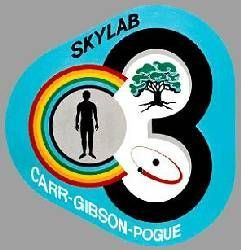 | Skylab 4 Credit: www.spacefacts.de |
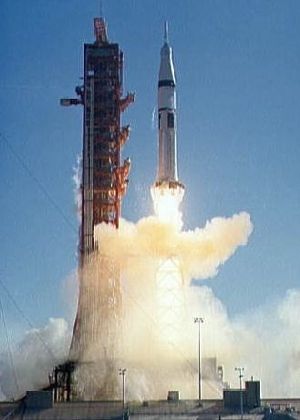 | Skylab 4 Launch of the Skylab 4/Saturn 1B space vehicle Credit: NASA |
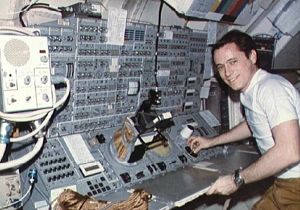 | Skylab 4 Astronaut Edward Gibson stands at Apollo Telescope Mount in Skylab Credit: NASA |
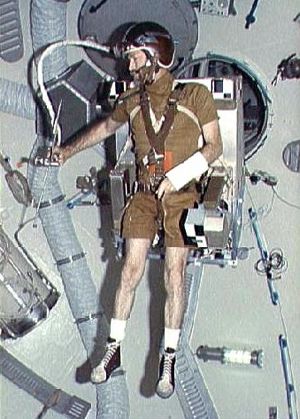 | Skylab 4 Astronaut Gerald P. Carr flies the Astronaut Manoeuvring Equipment in the OWS Credit: NASA |
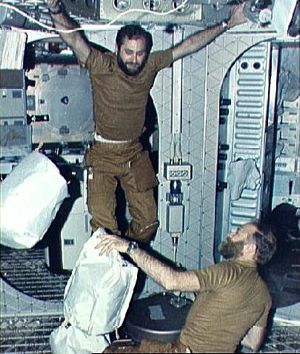 | Skylab 4 Skylab 4 crewmen passing trash bags in to the OWS waste disposal tank Credit: NASA |
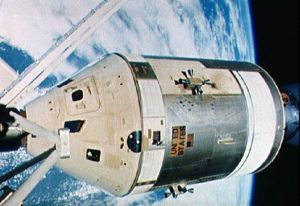 | Skylab 4 View of Skylab 4 Command/Service module in docked configuration Credit: NASA |
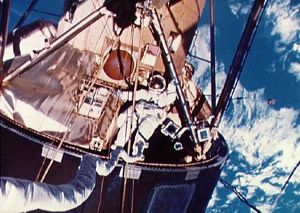 | Skylab 4 Astronaut Gerald Carr during EVA on Skylab 4 Credit: NASA |
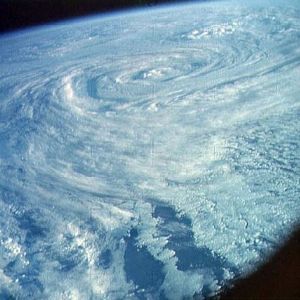 | Skylab 4 View of a South Pacific storm photographed from Skylab space station Credit: NASA |
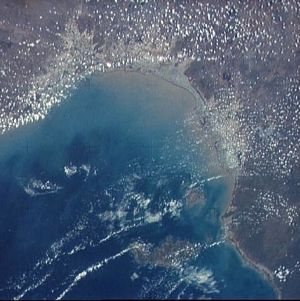 | Skylab 4 View of portion of Queensland, Australia from Skylab space station Credit: NASA |
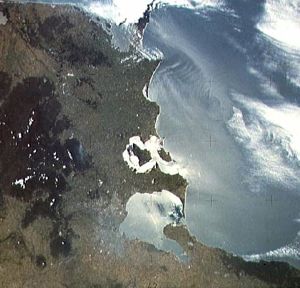 | Skylab 4 View of Melbourne, Australia as seen from Skylab space station Credit: NASA |
1973 August 7-15 - .
- Viewing program for the comet Kohoutek during the SL-4 mission. - .
Nation: USA.
Program: Skylab.
Flight: Skylab 4.
Representatives from NASA Hq, MSFC, GSFC, and JSC attended. Results of a feasibility study for viewing the comet were presented to the NASA Administrator on 15 August. It was agreed that observations of Kohoutek would he made at appropriate times during the SL-4 mission.
1973 August 14 - November 16 - .
- Skylab 4 space vehicle moved to Launch Complex 39B in readiness for rescue mission. - . Nation: USA. Program: Skylab. Flight: Skylab 4. The space vehicle consisted of a Saturn IB launch vehicle-S-IB-208 first stage, S-IVB-208 second stage, and S-IU-207 instrument unit; a CSM-118; and a spacecraft lunar module adapter.. Additional Details: here....
1973 August 16 - .
- SL 4 planning issues. - . Nation: USA. Program: Skylab. Flight: Skylab 4. Additional Details: here....
1973 September 6 - .
- Eye protection not for Kohoutek operations. - .
Nation: USA.
Program: Skylab.
Flight: Skylab 4.
At a Kohoutek status meeting, JSC w as requested to determine if additional ultraviolet eye protection would be required by the Skylab 4 astronaut while performing Kohoutek operations. A study indicated that no additional eye protective devices would be required for either intra- or extravehicular viewing of the comet. The use of the existing space suit sun visors would be required during extravehicular viewing.
1973 October 20 - .
- The crew of Skylab 4 began a 21-day prelaunch isolation period. - . Nation: USA. Program: Skylab. Flight: Skylab 4. Established prelaunch procedures required each Skylab flight crew to begin a health stabilization program 21 days before liftoff..
1973 October 30 - November 6 - .
- Two vials, each containing 500 gypsy moth eggs, were hand carried to JSC from the Department of Agriculture. - .
Nation: USA.
Program: Skylab.
Flight: Skylab 4.
Two vials, each containing 500 gypsy moth eggs, were hand carried to JSC from the Department of Agriculture. After being loaded in flight containers, they were hand carried to KSC. The eggs would be launched on Skylab 4 and then transferred to the OWS sleep compartment area where they would be monitored during the course of the SL-4 mission. The eggs were being carried at the request of the Secretary of Agriculture.
1973 November 6 - .
- A high-energy food bar was added to the menu of the Skylab 4 astronauts. - . Nation: USA. Program: Skylab. Flight: Skylab 4. The 72 kg of additional food placed aboard the SL-4 command module included 39 kg of high-energy food bars and would supply sufficient food for an extension of the mission to 85 days, plus an additional 10 days' supply for a rescue capability. . Additional Details: here....
1973 November 6 - .
- Skylab 4 delayed to replace cracked fins on the S-IB. - .
Nation: USA.
Program: Skylab.
Flight: Skylab 4.
A shift in the Skylab 4 launch schedule was required in order to replace eight cracked fins on the S-IB. The hairline cracks were discovered during a postcountdown demonstration test inspection. Initial indications were that the 14 cracks were caused by load stress or salt air, or possibly a combination of both.
1973 November 14 - .
- Skylab 4 ready for launch on 16 November 1973. - .
Nation: USA.
Program: Skylab.
Flight: Skylab 4.
Spacecraft: Skylab,
Apollo CSM.
A launch readiness review was held at KSC. From the review and closeout of action items, the Skylab 4 vehicle was determined to be ready for launch on 16 November 1973. Other reviews included the KSC flight readiness review, 18 October; the JSC Director's flight readiness review and the JSC command and service module flight readiness review, 11 October; the MSFC review of the Skylab Workshop systems capabilities, 17 September; and the KSC SL-4 launch readiness review, 15 October 1973.
1973 November 16 - . 14:01 GMT - . Launch Site: Cape Canaveral. Launch Complex: Cape Canaveral LC39B. Launch Platform: LUT1. LV Family: Saturn I. Launch Vehicle: Saturn IB.
- Skylab 4 - .
Call Sign: Skylab. Crew: Carr,
Gibson, Edward,
Pogue.
Backup Crew: Brand,
Lenoir,
Lind.
Payload: Apollo CSM 118. Mass: 20,847 kg (45,959 lb). Nation: USA.
Agency: NASA Houston.
Program: Skylab.
Class: Moon.
Type: Manned lunar spacecraft. Flight: Skylab 4.
Spacecraft: Apollo CSM.
Duration: 84.05 days. Decay Date: 1974-02-08 . USAF Sat Cat: 6936 . COSPAR: 1973-090A. Apogee: 437 km (271 mi). Perigee: 422 km (262 mi). Inclination: 50.00 deg. Period: 93.10 min.
Final Skylab mission; included observation and photography of Comet Kohoutek among numerous experiments. Completed 1,214 Earth orbits and four EVAs totalling 22 hours, 13 minutes. Increased manned space flight time record by 50%. Rebellion by crew against NASA Ground Control overtasking led to none of the crew ever flying again. Biological experiments included two Mummichog fish (Fundulus heteroclitus).
The space vehicle consisted of a modified Apollo CSM and a Saturn IB launch vehicle. All launch phase events were normal, and the CSM was inserted into a 150.1- by 227.08-km orbit. The rendezvous sequence was performed according to the anticipated timeline. Stationkeeping was initiated about seven and one-half hours after liftoff, and hard docking was achieved about 30 minutes later following two unsuccessful docking attempts. Planned duration of the mission was 56 days, with the option of extending it to a maximum of 84 days.
1973 November 17 - February 7 - .
- Skylab Orbital Workshop activation by the crew of Skylab 4. - .
Nation: USA.
Program: Skylab.
Flight: Skylab 4.
Spacecraft: Apollo ATM,
Skylab,
Skylab.
The reactivation included the reservicing of the airlock module primary coolant loop. The commander and pilot experienced symptoms resembling motion sickness during the initial three days of the visit, and flight plan activities were adjusted accordingly. Crew health was good thereafter. Additional Details: here....
1973 November 21 - .
- Skylab 4 - Wakeup Song: The Lonely Bull - . Flight: Skylab 4. "The Lonely Bull" by Herb Alpert & Tijuana Brass. CAPCOM: Henry Hartsfield.
1973 November 22 - .
- Skylab 4 - Wakeup Song: A Walk in the Black Forest - . Flight: Skylab 4. "A Walk in the Black Forest" Symbolic of the fact that the crew of Skylab 4 will be taking a walk in the blackness of space to repair the control system for an Earth-scanning antenna. CAPCOM: Henry Hartsfield.
1973 November 23 - . 17:42 GMT - .
- EVA Skylab 4-1 - . Crew: Gibson, Edward, Pogue. EVA Duration: 0.27 days. Nation: USA. Related Persons: Gibson, Edward, Pogue. Program: Skylab. Class: Manned. Type: Manned space station. Flight: Skylab 4. Spacecraft: Skylab. Repaired antenna. Replaced solar camera film cartridges..
1973 November 24 - .
- Skylab 4 - Wakeup Song: Paralyzed - . Flight: Skylab 4. "Paralyzed" by Legendary Stardust Cowboy CAPCOM: Bob Crippen.
1973 December 2 - .
- Skylab 4 - Wakeup Song: Misty - . Flight: Skylab 4. "Misty" by Julie London CAPCOM: Bob Crippen.
1973 December 3 - .
- Skylab 4 - Wakeup Song: The Sea - . Flight: Skylab 4. "The Sea" by Rod McKuen CAPCOM: Bob Crippen.
1973 December 4 - .
- Skylab 4 - Wakeup Song: Muskrat Ramble - . Flight: Skylab 4. "Muskrat Ramble" by Firehouse Five Plus Two CAPCOM: Bob Crippen.
1973 December 6 - .
- Skylab 4 - Wakeup Song: Silent Night - . Flight: Skylab 4. "Silent Night" by Barbra Streisand; a message from the people of Germany followed by German Christmas songs. Santa Claus Day in Germany falls on this date..
1973 December 7 - .
- Skylab 4 - Wakeup Song: The Party's Over - . Flight: Skylab 4. "The Party's Over" by Julie London.
1973 December 10 - .
- Skylab 4 - Wakeup Song: Lonely Bull (El Solo Toro) - . Flight: Skylab 4. "Lonely Bull (El Solo Toro)" by Herb Alpert & Tijuana Brass.
1973 December 11 - .
- Skylab 4 - Wakeup Song: Peanut Vendor - . Flight: Skylab 4. "Peanut Vendor" by Chet Atkins CAPCOM: Henry Hartsfield.
1973 December 13 - .
- Skylab 4 - Wakeup Song: Eli's Coming - . Flight: Skylab 4. "Eli's Coming" by Three Dog Night.
1973 December 14 - .
- Skylab 4 - Wakeup Song: Blue Tail Fly - . Flight: Skylab 4. "Blue Tail Fly" by Burl Ives CAPCOM: Richard Truly.
1973 December 23 - .
- Skylab 4 - Wakeup Song: The Little Drummer Boy - . Flight: Skylab 4. "The Little Drummer Boy" Christmas music.
1973 December 24 - .
- Skylab 4 - Wakeup Song: The Twelve Days of Christmas - . Flight: Skylab 4. "The Twelve Days of Christmas" ,"The Little Drummer Boy".
1973 December 25 - .
- Skylab 4 - Wakeup Song: Ring Christmas Bells - . Flight: Skylab 4. "Ring Christmas Bells".
1973 December 25 - . 16:00 GMT - .
- EVA Skylab 4-2 - . Crew: Carr, Pogue. EVA Duration: 0.29 days. Nation: USA. Related Persons: Carr, Pogue. Program: Skylab. Class: Manned. Type: Manned space station. Flight: Skylab 4. Spacecraft: Skylab. Photographed Comet Kohoutek and replaced solar camera film cartridges..
1973 December 29 - .
- Skylab 4 - Wakeup Song: Joy to the World - . Flight: Skylab 4. "Joy to the World" by Three Dog Night CAPCOM: Bob Crippen.
1973 December 29 - . 17:00 GMT - .
- EVA Skylab 4-3 - . Crew: Carr, Gibson, Edward. EVA Duration: 0.14 days. Nation: USA. Related Persons: Carr, Gibson, Edward. Program: Skylab. Class: Manned. Type: Manned space station. Flight: Skylab 4. Spacecraft: Skylab. Photographed Comet Kohoutek..
1973 December 30 - .
- Skylab 4 - Wakeup Song: On Top of the World - . Flight: Skylab 4. "On Top of the World" by"The Carpenters" CAPCOM: Bob Crippen.
1973 December 31 - .
- Skylab 4 - Wakeup Song: Come Back My Love - . Flight: Skylab 4. "Come Back My Love" by Brigitte Bardot.
1974 January 1 - .
- Skylab 4 - Wakeup Song: Auld Lang Syne - . Flight: Skylab 4. "Auld Lang Syne" Guy Lombardo"Paralyzed" by Legendary Stardust Cowboy.
1974 January 3 - .
- Skylab 4 - Wakeup Song: Peter, Paul, and Mary medley - . Flight: Skylab 4. "Peter, Paul, and Mary medley" CAPCOM: Henry Hartsfield.
1974 January 4 - .
- Skylab 4 - Wakeup Song: Chet Atkins medley - . Flight: Skylab 4. "Chet Atkins medley".
1974 January 5 - .
- Skylab 4 - Wakeup Song: Strawberry Roan - . Flight: Skylab 4. "Strawberry Roan" and"El Paso" by Marty Robbins Commander Gerald P. Carr commented:"Gene Autry, eat your heart out" CAPCOM: Henry Hartsfield.
1974 January 6 - .
- Skylab 4 - Wakeup Song: Herb Alpert Tijuana Brass medley - . Flight: Skylab 4. "Herb Alpert Tijuana Brass medley" CAPCOM: Henry Hartsfield.
1974 January 12 - .
- Skylab 4 - Wakeup Song: Come Saturday Morning - . Flight: Skylab 4. "Come Saturday Morning" CAPCOM: Bruce McCandless.
1974 January 13 - .
- Skylab 4 - Wakeup Song: Light My Fire - . Flight: Skylab 4. "Light My Fire" by The Lettermen (sic) CAPCOM: Bruce McCandless.
1974 January 14 - .
- Skylab 4 - Wakeup Song: Neil Diamond vocal - . Flight: Skylab 4. "Neil Diamond vocal" CAPCOM: Bruce McCandless.
1974 January 15 - .
- Series of engineering tests on the Orbital Workshop authorized following completion of the Skylab 4 mission. - .
Nation: USA.
Program: Skylab.
Flight: Skylab 4.
Series of engineering tests on the Orbital Workshop authorized following completion of the Skylab 4 mission. A series of engineering tests on the Orbital Workshop was authorized following completion of the Skylab 4 mission provided that only tests which would result in significant engineering knowledge would be performed. Additional Details: here....
1974 January 15 - .
- Skylab 4 - Wakeup Song: The First Time Ever I Saw Your Face - . Flight: Skylab 4. "The First Time Ever I Saw Your Face" CAPCOM: Bruce McCandless.
1974 January 16 - .
- Skylab 4 - Wakeup Song: Spiders and Snakes - . Flight: Skylab 4. "Spiders and Snakes" CAPCOM: Bruce McCandless.
1974 January 17 - .
- Skylab 4 - Wakeup Song: O What a Beautiful Morning - . Flight: Skylab 4. "O What a Beautiful Morning" CAPCOM: Bob Crippen.
1974 January 19 - .
- Skylab 4 - Wakeup Song: Off We Go Into the Wild Blue Yonder - . Flight: Skylab 4. "Off We Go Into the Wild Blue Yonder" - The Air Force Song -"Anchors Aweigh" &"Ear Splitting Louder Boomer" by Steppenwolf. The last for lone civilian of crew, pilot Ed Gibson CAPCOM: Bob Crippen.
1974 January 20 - .
- Skylab 4 - Wakeup Song: Marines Hymn - . Flight: Skylab 4. "Marines Hymn" ,"Quiet Village","Hawaiian War Chant" CAPCOM: Bob Crippen.
1974 January 21 - .
- Skylab 4 - Wakeup Song: The Party's Over - . Flight: Skylab 4. "The Party's Over" by Julie London"Misty" by Julie London CAPCOM: William Thornton.
1974 January 22 - .
- Skylab 4 - Wakeup Song: Spiders and Snakes - . Flight: Skylab 4. "Spiders and Snakes" CAPCOM: Richard Truly.
1974 January 23 - .
- Skylab 4 - Wakeup Song: Happy Birthday - . Flight: Skylab 4. "Happy Birthday" "For He's a Jolly Good Fellow" by Pogue family In honor of Bill Pogue CAPCOM: Richard Truly.
1974 January 24 - .
- Skylab 4 - Wakeup Song: Misty - . Flight: Skylab 4. "Misty" CAPCOM: Richard Truly.
1974 January 25 - .
- Skylab 4 - Wakeup Song: On Top of the World - . Flight: Skylab 4. "On Top of the World" by The Carpenters CAPCOM: Richard Truly.
1974 January 26 - .
- Skylab 4 - Wakeup Song: In the Wee Small Hours of the Morning - . Flight: Skylab 4. "In the Wee Small Hours of the Morning" by Julie London CAPCOM: Richard Truly.
1974 January 27 - .
- Skylab 4 - Wakeup Song: El Manicero - . Flight: Skylab 4. "El Manicero" Herb Alpert & Tijuana Brass?.
1974 January 28 - .
- Skylab 4 - Wakeup Song: A medley of soft music.. - . Flight: Skylab 4. "A medley of soft music.." CAPCOM: Henry Hartsfield.
1974 January 29 - .
- Skylab 4 - Wakeup Song: If - . Flight: Skylab 4. "If" by Bread;"Gypsies, Tramps, and Thieves" by Cher; and"Sensuous Woman" by Mystic Moods CAPCOM: Henry Hartsfield.
1974 January 30 - .
- Skylab 4 - Wakeup Song: Ghost Riders in the Sky - . Flight: Skylab 4. "Ghost Riders in the Sky" CAPCOM: Henry Hartsfield.
1974 January 31 - .
- Skylab 4 - Wakeup Song: Burning Love - . Flight: Skylab 4. "Burning Love" by Elvis Presley CAPCOM: Henry Hartsfield.
1974 February 3 - .
- Skylab 4 - Wakeup Song: Walk Through the Black Forest - . Flight: Skylab 4. "Walk Through the Black Forest" by Herb Alpert & Tijuana Brass.
1974 February 3 - . 15:19 GMT - .
- EVA Skylab 4-4 - . Crew: Carr, Gibson, Edward. EVA Duration: 0.22 days. Nation: USA. Related Persons: Carr, Gibson, Edward. Program: Skylab. Class: Manned. Type: Manned space station. Flight: Skylab 4. Spacecraft: Skylab. Retrieved solar camera film cartridges and external materials exposure package..
1974 February 4 - .
- Skylab 4 - Wakeup Song: Rachmaninoff Concerto No. 3 - . Flight: Skylab 4. "Rachmaninoff Concerto No. 3" played by Van Cliburn.
1974 February 5 - .
- Skylab 4 - Wakeup Song: Out in the Country - . Flight: Skylab 4. "Out in the Country" by Three Dog Night" and"I Feel the Earth Move" by Carole King. CAPCOM: Henry Hartsfield.
1974 February 6 - .
- Skylab 4 - Wakeup Song: Soul of Spain - . Flight: Skylab 4. "Soul of Spain" by 101 Strings.
1974 February 7 - .
- Skylab 4 - Wakeup Song: Carmen - . Flight: Skylab 4. "Carmen" by Bizet and"Shaft" by Isaac Hayes CAPCOM: Bruce McCandless.
1974 February 8 - .
- Skylab 4 - Wakeup Song: Goin'Back to Houston - . Flight: Skylab 4. "Goin'Back to Houston" by Dean Martin Apollo-SOYUZ TEST PROJECT (ASTP) July 15-24, 1975.
1974 February 8 - . 15:16 GMT - .
- Landing of Skylab 4 - . Return Crew: Carr, Gibson, Edward, Pogue. Nation: USA. Related Persons: Carr, Gibson, Edward, Pogue. Program: Skylab. Flight: Skylab 4. Skylab 4 landed at 15:16 GMT. .
1974 February 9 - .
- All primary mission objectives of Skylab 4 were reported accomplished. - . Nation: USA. Program: Skylab. Flight: Skylab 4. Spacecraft: Skylab. Additional Details: here....
1974 July - .
- Comet Kohoutek and Skylab - .
Nation: USA.
Program: Skylab.
Flight: Skylab 4.
A JSC report summarized Comet Kohoutek's relationship to Skylab operations: Comet Kohoutek was discovered on 7 March 1973, three months before the launch of Skylab. Preliminary feasibility studies indicated that there was insufficient time to send a suitably instrumented spacecraft to observe and study the comet at close range. However, other manned and unmanned observations were planned, with the most significant to occur during the third visit to the orbiting Skylab. Unique scientific data were obtained by the third-visit crew, helping to make Kohoutek the most comprehensively studied comet in history. Additional Details: here....
Back to top of page
Home - Search - Browse - Alphabetic Index: 0- 1- 2- 3- 4- 5- 6- 7- 8- 9
A- B- C- D- E- F- G- H- I- J- K- L- M- N- O- P- Q- R- S- T- U- V- W- X- Y- Z
© 1997-2019 Mark Wade - Contact
© / Conditions for Use